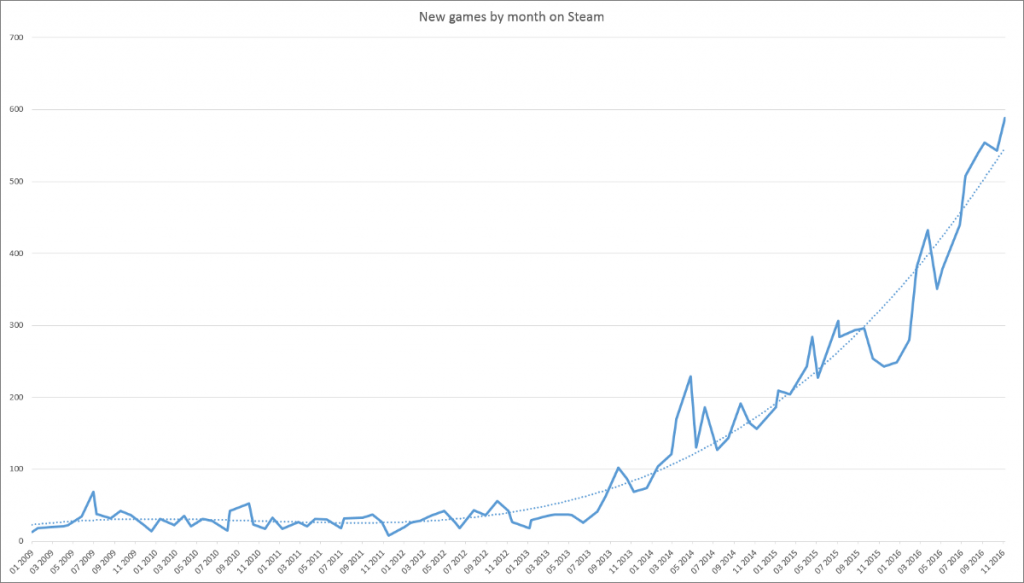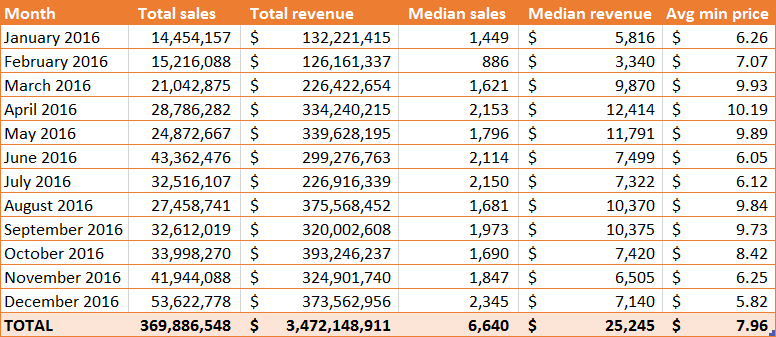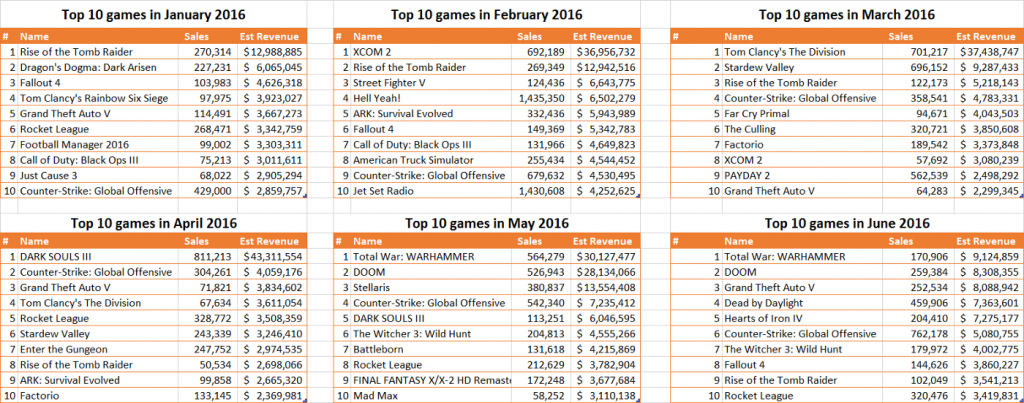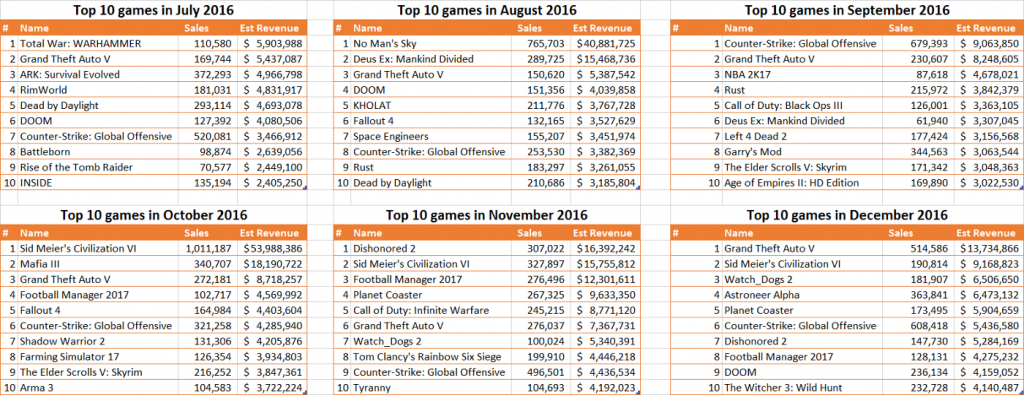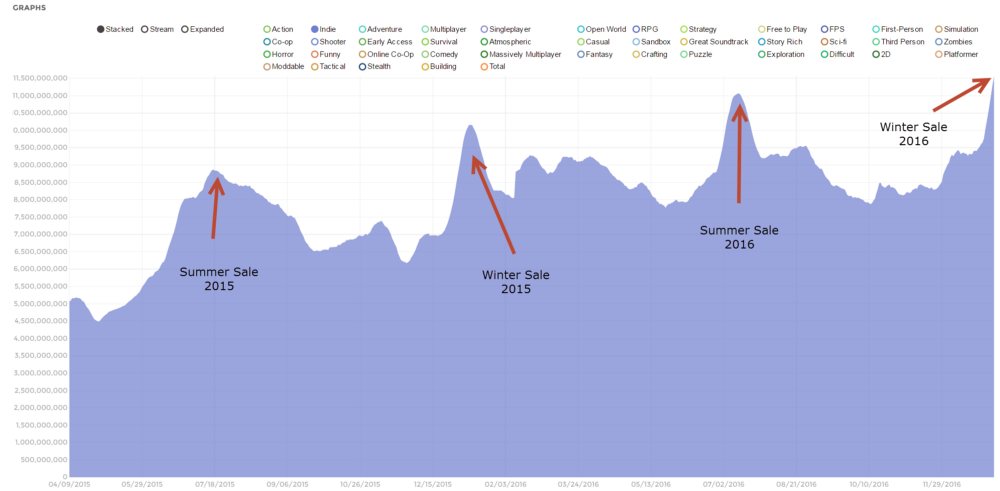Sergey Galenkin in his blog on Medium spoke in detail about the results of 2016 on Steam. With the author’s permission, we publish a translation of his article.

In 2016, 5245 new games appeared on Steam – this is the most generous year for new releases so far. At the same time, sales and revenue from paid titles remained at the same level as in 2015.
Important: The figures below are collected using Steam Spy. The service uses statistical analysis, and the result is not 100% accurate.
There are more and more games every month
At the beginning of the year, the number of new releases decreased slightly, and then began to grow again and reached an impressive 588 titles in December alone.
In general, sales followed the same scenario as in 2015: the end of the year was the most profitable period.
Here are the numbers in a more convenient format:
As you can see, in 2016, approximately 370 million new games found their players. Naturally, this includes sales outside of Steam, bundles, free giveaways of games and stock games. As far as possible, I tried to take into account most of these sales, but I probably missed something.
The median values were calculated based on data on 8996 games for which I have sales statistics for 2016. I don’t have data for each month for each game, so the median sales values for the year are less than the sum of the median monthly sales.
On average, in 2016, the game on Steam sold 6,640 copies and earned $25,245.
Due to off-Steam sales and giveaways, the real numbers are most likely lower.
The total volume of the paid games market on Steam reaches an impressive $ 3.5 billion!
This, of course, is not the total sales volume on Steam, since there are many other ways to purchase the game. But the volume of the paid games market controlled by Valve is exactly that.
The actual volume of sales of paid games on Steam is below the figures given here — but at the same time, do not forget that this number does not include DLC sales or revenue from shareware projects.
Important: Not all games purchased through Steam were sold using this platform, and vice versa (GTA V, The Witcher 3). Some publishers report that up to a third of the revenue from games released on Steam came from third-party stores. Yes, $3.5 billion is a lot of money. But compared to 2015, when the market volume, according to my estimates, reached the same $ 3.5 billion, the difference is small.
Important: in this particular case, the margin of error is quite high. To estimate revenue, I used three different methods, and the resulting number varies from $3.3 billion to $3.6 billion.
The reason is simple. Yes, Steam did release a lot more games than in 2015, but there were fewer major titles. It’s hard to compete with such a combo — GTA V, Fallout 4 and The Witcher 3.
In addition, sales of Call of Duty: Infinite Warfare were weaker than sales of Black Ops 3, and two other notable shooters (Overwatch and Battlefield 1) were not distributed through Steam at all.
This stagnation may also be explained by the fact that the growth of the Steam audience in the USA and Western Europe has slowed down. The platform is increasingly popular among Chinese players and users of other Asian countries, but they cannot compete in purchasing power with gamers from richer regions.
Plus, Asian players tend to like online games more than paid singleplayers. So CS:GO, GTA V and other online projects benefit from Asian expansion, but traditional paid titles are still no use from it.
In general, judging by how rapidly the CS audience is growing:GO, things are going uphill for Valve — even taking into account the fact that sales of paid titles and the Dota 2 user base remained at about the same level as in 2015.
Important: In February 2016, I changed the algorithm for counting users. Because of this, the February statistics on Steam Spy turned out to be overstated, since the total figure included “missing” users and sales for the period from October 2015 to January 2016. For the article, I manually changed the numbers, but everything remained the same on the site.
And the winners are…
When composing the plates, I removed the errors as far as possible and took into account the regional difference in price.
For example, in the original version GTA V was at the top of the list. But a significant part of the audience of this game is from China and Russia, where the title is cheaper. Therefore, I recalculated the revenue taking into account the difference in price.
Another interesting example is Football Manager 2017. The game is well represented in the retail European market, especially in the UK — which means we are most likely seeing only the tip of the iceberg.
The list of the most popular games on Steam compiled by Valve itself is more reliable, since the company knows exactly which sales are accounted for by Steam, and which are accounted for by other stores.
Monthly sales
I repeat, I did what I could to remove free giveaways and bundles from the list, but still treat it (like everything in this life) with a degree of skepticism.
As you can see, GTA V, Fallout 4 and The Witcher 3 are still selling great — despite being released in 2015. And CS:GO has torn everyone apart in general: it attracted almost 7 million new users in a year.
What about indie games?
Indie games are still being played. Moreover, during the last winter sale, Indie games were played more than ever.
The total time spent by players in Indie projects (the timeline is divided into two-week segments).
It is slightly disturbing that the peaks of user activity last a little less compared to the summer sale. But on the other hand, they have become higher — so that players really play indie games much more during sales (that is, more people spend more time in the game). It’s just that after the sale ends, they don’t spend much time in the game.
The total time spent by players in Indie projects (the timeline is divided into two-week segments).
Titles from “Early Access” also involve users very well, but at the same time their indicators depend less on sales.
Survivalists are being replaced by indie strategies
Interestingly, in 2016, there were much fewer successful survivalists from indie developers in the top. The Top 100 mostly includes serious projects from major studios (ARK, Rust, Subnautica, H1Z1). And yet, both The Culling and The Astroneer (both projects are survivalists, — approx. editors) things are going very well. At the same time, the list of top games includes a bunch of good and quite successful indie strategies and managers: Stardew Valley, RimWorld, Factorio, Planet Coaster, Slim Rancher, Scrap Mechanic, Youtubers Life. And this is not counting new games from well-known developers, such as Civilization VI, XCOM 2, Stellaris, Total War: Warhammer, Football Manager 2017, Master of Orion.
So if 2015 can be called the year of survivalists, then 2016 has become the year of strategies. I wonder what to expect from 2017?
Translated by Irina Smirnova
Source: Sergey Galenkin’s blog on Medium

